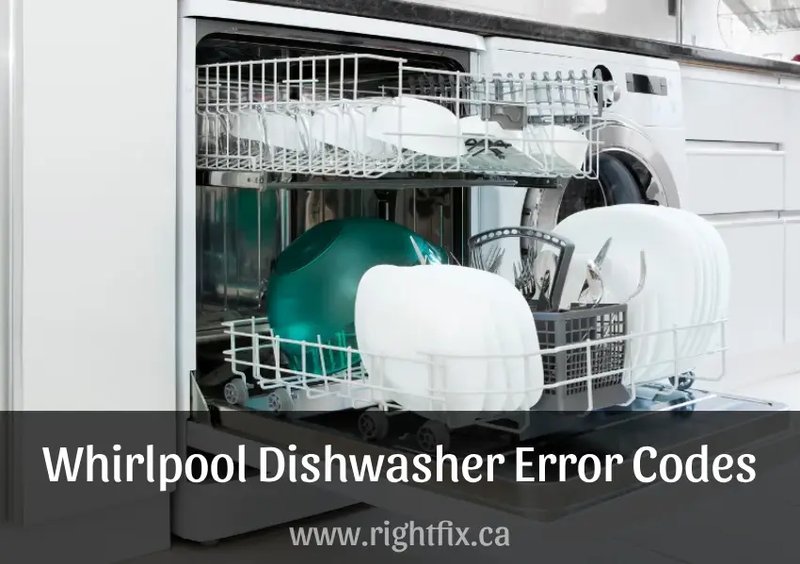
Error codes are your dishwasher’s way of communicating that something isn’t quite right. Think of it as your appliance waving a little red flag to catch your attention. The E3 error code in Whirlpool dishwashers specifically relates to a problem with the heating system. This code usually pops up when the machine detects that water isn’t reaching the correct temperature as expected. Just like trying to take a hot shower only to find that the water is just lukewarm, your dishwasher needs the water to be hot enough to clean effectively.
Understanding the E3 Error Code
The E3 error signifies an issue with the water heating process in your dishwasher. This is more than just a minor inconvenience because the right water temperature is crucial for effective dishwashing. If the water isn’t hot enough, your dishes might not come out sparkling clean, and no one likes the idea of having to rewash dishes by hand.
Now, you might be asking, why does the water temperature matter so much? Well, hot water helps to break down food residues and grease, allowing detergents to work better. If your dishwasher can’t heat the water to the optimal temperature, you’re likely to notice that food particles remain stuck to your plates and utensils. Plus, properly heated water helps to sanitize dishes, keeping them safe to use for your next meal.
When the E3 code appears, it’s important to address it promptly. Ignoring it could lead to poor dishwashing results and potentially more serious appliance issues down the line. Fortunately, most E3 error causes are quite manageable, even for someone who’s not a DIY expert. Let’s look at these causes and how you might troubleshoot them.
Common Causes of the E3 Error Code
The E3 error code can be triggered by a few common issues, and the first one is a malfunctioning heating element. Imagine trying to boil water on a stove with a broken burner. It simply won’t heat up! Similarly, if your dishwasher’s heating element is faulty, it won’t warm the water properly. The heating element is a crucial part of the dishwasher, and a failure here can cause the E3 error to appear. Inspecting and replacing a defective heating element is often necessary to fix this issue.
Another potential culprit is a faulty thermostat. The thermostat acts like a thermometer combined with a light switch for the heating element. It tells the element when to turn on and off to keep the water at the right temperature. If the thermostat isn’t working properly, it may not communicate efficiently with the heating system, leading to the E3 error. In some cases, simply resetting or replacing the thermostat can solve the problem.
Water inlet issues can also cause the E3 code to pop up. Just like a clogged faucet disrupts the flow of water, a problem with the water inlet valve might prevent enough water from entering the dishwasher. This means there isn’t enough water to heat up, triggering the error code. Checking the water inlet for clogs or malfunctions could be another step towards resolving this issue.
How to Troubleshoot and Fix E3
So, what can you do if you see the E3 error code flashing at you? First, it’s always a good idea to start with the basics. Give your dishwasher a quick reset by turning it off and unplugging it for a minute or two. Sometimes, just like restarting your phone when it’s acting up, this can clear minor glitches.
Next, take a closer look at the heating element. Visually inspect it for any obvious signs of damage, such as cracks or burns. If you have a multimeter handy, you can test for continuity. No continuity means the element likely needs replacing. Don’t worry if you’re not confident doing this yourself; it might be worth calling a professional for this step.
Also, consider checking the thermostat. Make sure it’s functioning correctly. If necessary, replace it with a new one. Remember, safety first! Always ensure the appliance is switched off before inspecting or handling any of its parts.
If these fixes don’t solve the problem, it might be time to inspect the water inlet valve. Ensure there’s no blockage and that water flows freely. Sometimes, cleaning or replacing the valve could get your dishwasher back to optimal performance.
Preventing Future E3 Errors
To avoid running into the E3 error code again, regular maintenance is key. Think of it like brushing your teeth to prevent cavities. Regularly cleaning your dishwasher’s filter can help maintain proper water flow and temperature. Keep an eye on your dishwasher’s performance, and don’t ignore minor issues that could escalate.
Using your dishwasher correctly also helps. Make sure not to overload it, as this can affect water flow and pressure. Plus, using the right amount and type of detergent ensures that your appliance runs efficiently.
In conclusion, while the E3 error code can seem frustrating, understanding its causes and how to address them can get your dishwasher back to making your dishes sparkle. With a little patience and regular maintenance, you can keep your Whirlpool running smoothly — no professional repair required! If things do seem out of hand, remember that calling in an expert is always a good plan. Happy dishwashing!